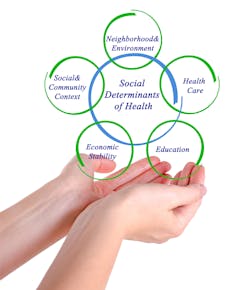How UnitedHealthcare Is Integrating Data to Move the Needle on Inequities
Speaking during WEDI’s “Quest for Health Equity” virtual program on March 24, L.A. Care Health Plan’s James Kyle, M.D., urged health plans to consider the responsibility they have to partner on community efforts to reduce health disparities. On the same panel, Catherine Anderson, senior vice president for policy and strategic engagement at UnitedHealthcare, discussed the importance of gathering and integrating actionable data to address those disparities.
Anderson said United Healthcare is putting considerable effort into bolstering its data infrastructure, particularly as it relates to some of the most complex populations that it serves. “That work is really focused on how we take disparate data elements into our organization in such a way as to make an impact on the populations that we serve,” she said. “And one of the things that we are faced with is the reality that sometimes a wealth of data actually is problematic as we start to think about how we use data in a way that is meaningful and impactful. Having a lot of data doesn't mean that we have sufficient data or the right data or data that can be used to inform our thinking about how we would have a meaningful impact in the communities and on the members themselves.”
UnitedHealthcare has a ton of claims data, but that data has time lags and is incomplete. “If you are, a physician in an exam room with a member and you identify homelessness, and that member walks out the door, and it takes 12 days for the claim to hit our system, that lag becomes pretty significant in our ability to meet an immediate need,” she said.
Although there are lots of healthcare provider efforts under way across the country to understand the social needs of the patients they serve, “that data often resides in places where it's difficult to get to,” Anderson said. It may be sitting in an EHR or the system of a third-party vendor. “There's inconsistency in the approach, which requires us to think about how we get that data in such a way that we could package it together and use it to inform our thinking. And then, quite frankly, there are some basics that are missing.” She said race and ethnicity data, often missing, is fundamental to thinking about overcoming historic and systemic racism issues and to help support investments that can make a meaningful difference. “So while we've got a lot of data, I would say that the puzzle is not yet complete. There is lots of work still to be done.”
There are several things that UnitedHealthcare has done to focus on improving its understanding of the inequities that its members and communities face. Data that comes from EHRs and care management platforms can give a very rich view of the members in terms of what their immediate and long-term needs are. The company also has built a registry of social data coming from a variety of places, first and foremost, through its own member engagement. “If a member calls one of our navigators and states the challenges that they are facing, we're capturing that data and it's flowing into our registry, where we're able to match it to the clinical data seamlessly to have a better view of our individual members, and then collectively of the population that's being served,” Anderson said.
UnitedHealthcare also has partnerships with both providers and other vendors who provide data for the registry. “This provides us the opportunity from a data-matching perspective to look at how we put the information that we know about our members together with the clinical information that we we've gathered, and match it to the social data,” she explained. “So much of the outcomes, both from a cost and quality-of-life perspective, are really driven by the social needs that a member has, not by the clinical interventions that we can provide. So understanding the depth of challenges from a social determinants perspective is vital to us in terms of moving the needle for each individual member as well as for entire communities and populations.”
Today, UnitedHealthcare does not have a one-to-one match for each member from a clinical and social needs perspective, so it is looking at other tools such as a social deprivation index to get a sense of what's happening at a community level. “It helps us get a better understanding from a hot-spotting perspective of where we should be focusing energy and aligning resources,” Anderson said. “That allows us to have a much better sense of the opportunities that we collectively have to move the needle on improving outcomes and truly addressing health inequities.”
The organization has launched five pilots across the country, with plans to expand in 2021, in partnership with public housing authorities. “Through matching data from the public housing authority to our clinical and social data, we're able to see the difference in Akron vs. what members of the community need in Seattle,” Anderson said. “By understanding what the needs are and where the gaps in services are and where the challenges around access exist, it allows us to be laser-focused on what we we should do in Akron and what partnerships we should be forging in Akron vs. what we should be forging in Seattle or Austin. So the combination of data is really helping us to be much more focused on the clinical interventions.
She said UnitedHealthcare can work with the public housing authority by informing them of information they would not have that allows for investments in new ventilation or removal of carpeting to reduce incidences of acute asthma attacks. “That allows us to deploy clinical resources into the public housing authority to coach on the use of medication or encouraging primary care vs. acute or emergent care,” Anderson said. “That then informs our thinking around how we incentivize our providers — how we work with community-based organizations to create alternative payment models that really focus in on what's the right thing to do for our population to move the needle and include really targeted incentives to improve outcomes,” she said. “That also informs our thinking about where we make investments from a social impact perspective. If we aren't well informed, we could be making investments that, frankly, won't move the needle. And so understanding the richness of the social data, understanding access and how people are getting services or not getting services and where those gaps are truly informs our thinking and our understanding of where to deploy investments in a meaningful way.”


